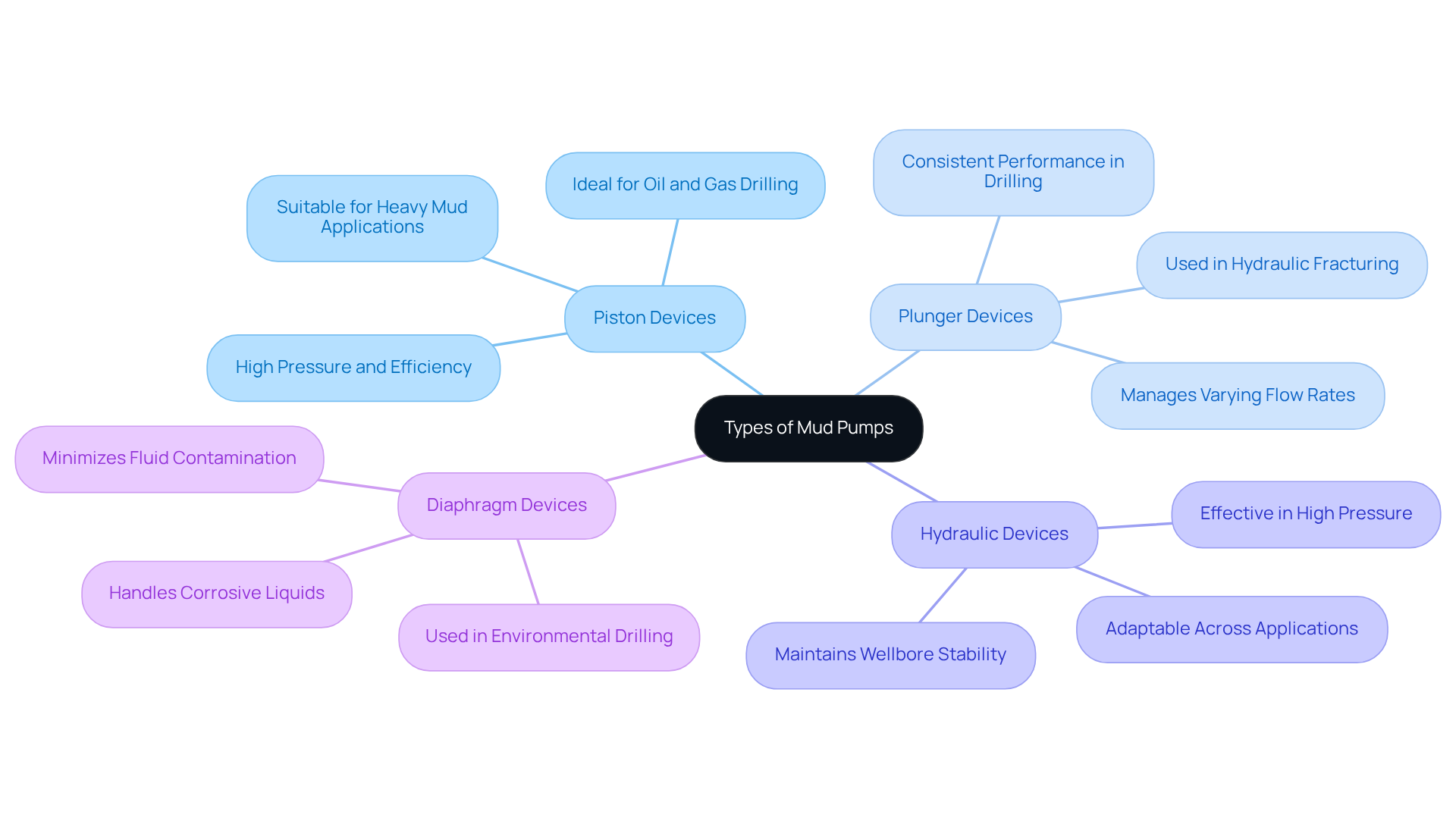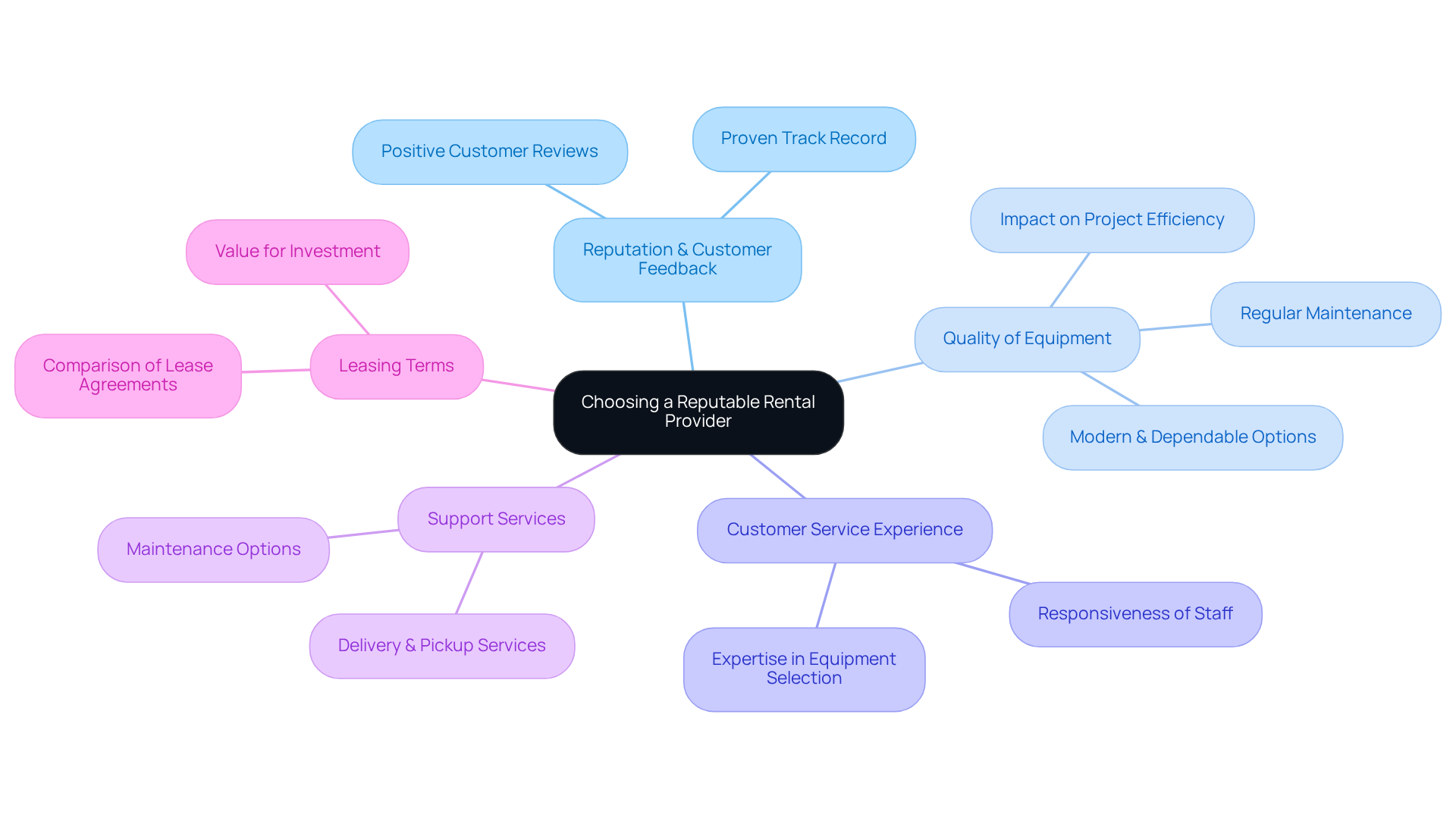Overview
This article outlines four essential tips for renting mud pumps, underscoring the importance of:
- Understanding various pump types
- Evaluating rental needs
- Selecting a reputable provider
- Meticulously reviewing rental agreements
Each tip is supported by detailed insights into pump functionalities and key considerations for project requirements. Furthermore, the significance of provider reliability and contract clarity cannot be overstated; these factors collectively ensure a successful and efficient rental experience.
Understanding the different types of mud pumps available is crucial for making informed rental decisions. Each pump type serves distinct functions and applications, which can significantly impact project outcomes. Evaluating your specific rental needs will help you select the appropriate equipment, ensuring that your project runs smoothly and efficiently.
Choosing a reputable provider is another pivotal step in the rental process. A reliable provider not only offers quality equipment but also provides valuable support and guidance throughout the rental period. Thoroughly reviewing rental agreements is equally important; clarity in contracts protects your interests and fosters a transparent rental experience.
In conclusion, by following these essential tips, you position yourself for success in the mud pump rental process. Engage with a trusted provider today to ensure that you have the right equipment for your needs, backed by reliable service and clear agreements.
Key Highlights:
- Four main types of mud pumps: piston, plunger, hydraulic, and diaphragm, each with unique applications.
- Piston devices excel in high-pressure environments and heavy mud applications.
- Plunger devices manage varying flow rates, ideal for hydraulic fracturing.
- Hydraulic devices are adaptable for construction and mining, effective in high-pressure fluid transfer.
- Diaphragm devices handle corrosive liquids, minimising contamination in environmental drilling.
- Evaluate project scope, duration, specific requirements, budget, and contingency plans when renting mud pumps.
- Consider provider reputation, equipment quality, customer service, and support services when selecting a rental provider.
- Review rental agreements thoroughly, clarifying maintenance duties, hidden fees, liability clauses, and insurance requirements.
Introduction
Understanding the intricacies of mud pumps is essential for any construction or drilling project, as these tools play a pivotal role in efficient operations. This article delves into four critical tips designed to empower readers to navigate the rental process effectively, ensuring they select the right equipment tailored to their specific needs.
However, with numerous options available and potential pitfalls lurking in rental agreements, how can one ensure they make informed choices that align with their project goals?
In addition, recognizing the importance of reliability and quality in equipment selection will further enhance project success.
Understand Mud Pumps: Types and Functions
Understanding the various types of mud devices is critical for efficient project execution. Familiarize yourself with the four primary types: piston, plunger, hydraulic, and diaphragm devices. Each type boasts distinct operational mechanisms and applications in construction and drilling.
Piston Devices: Known for their high pressure and efficiency, piston devices are ideal for applications that require precise fluid delivery, such as in oil and gas drilling. They perform exceptionally well in high-viscosity environments, making them suitable for heavy mud applications.
Plunger Devices: These devices are preferred for their capacity to manage varying flow rates and pressures. They are commonly employed in scenarios where consistent performance is essential, such as in hydraulic fracturing and other drilling operations.
Hydraulic Devices: Hydraulic devices offer adaptability and can be utilized across numerous applications, including construction and mining. They are particularly effective in transferring fluids under high pressure, making them indispensable for maintaining wellbore stability during drilling.
Diaphragm Devices: Recognized for their ability to handle corrosive and abrasive liquids, diaphragm devices are frequently utilized in scenarios where minimizing fluid contamination is crucial, such as in environmental drilling projects.
When evaluating specifications, consider flow rates, pressure capabilities, and compatibility with the materials being pumped. For example, the global mud device market is projected to expand significantly, with triplex units expected to dominate due to their effectiveness in high-pressure operations, commanding over 74% market share by 2026. Furthermore, the market is anticipated to grow at a CAGR of 4.70% during the forecast period, indicating robust demand for these essential tools.
Aligning the type of device with your project's specific needs, such as mud weight and viscosity, is vital for optimal performance. Investigate the typical applications for each type of device to make informed decisions that align with your objectives. Understanding these factors will empower you to select the appropriate tools for your construction or drilling requirements.

Evaluate Your Rental Needs: Key Considerations
To effectively rent a mud pump for your construction project, several key considerations must be evaluated:
-
Determine Project Scope: Clearly define the size and complexity of your project. This evaluation will assist you in determining the specific equipment required, ensuring that the mud device aligns with your operational needs.
-
Assess Duration: Accurately estimating the duration for which you will need the mud pump is crucial. Overestimating can lead to unnecessary leasing expenses, while underestimating may result in project delays. Recent trends indicate that many contractors are increasingly focused on optimizing rental durations to enhance cost efficiency.
-
Identify Specific Requirements: Consider the technical specifications of the mud pump, such as flow rate, pressure, and the type of mud being pumped. These factors are essential for ensuring that the tools fulfill the requirements of your project.
-
Budget Considerations: Establish a comprehensive budget for leasing costs, factoring in potential maintenance and operational expenses. The U.S. construction and industrial machinery leasing market size is valued at $36.5 billion. As the construction machinery leasing sector is expected to expand notably, with a compound annual growth rate of 4.4% through 2034, being aware of your budget will assist you in navigating the competitive landscape successfully.
-
Plan for Contingencies: Always account for possible delays or changes in project scope that may influence your resource requirements. Flexibility in your lease agreement can provide a safety net against unforeseen circumstances, allowing you to adapt without incurring excessive costs. Notably, 62% of respondents cited flexibility in returning equipment as a primary reason for renting, emphasizing the importance of this consideration.
By thoroughly assessing these factors, you can ensure that your project objectives and budget align with the mud pumps for rent, ultimately aiding in a successful construction result.

Choose a Reputable Rental Provider: What to Look For
When selecting a provider for mud pumps for rent, prioritize firms that have a strong reputation and positive customer feedback. A proven track record in machinery rentals, particularly mud pumps for rent, is essential, reflecting both reliability and customer satisfaction.
Quality of equipment is paramount; ensure that the provider regularly maintains their mud pumps for rent and offers modern, dependable options. In 2025, customer reviews increasingly emphasize the significance of machinery quality, with many users stressing that well-maintained devices greatly influence project efficiency and safety.
Evaluate the customer service experience by assessing the responsiveness and expertise of the provider's staff. Expert insights reveal that skilled personnel can significantly impact the leasing process, assisting clients in selecting the appropriate tools for their specific requirements.
Inquire about support services for mud pumps for rent, including maintenance, delivery, and pickup options. A provider that offers comprehensive support can enhance your leasing experience by ensuring that mud pumps for rent are available and ready for use when needed.
Finally, compare leasing terms across different providers. Examining lease agreements will help you recognize the best terms and conditions, guaranteeing that you obtain value for your investment. With the tools leasing market expected to expand considerably, making informed decisions now will lay the groundwork for successful initiatives ahead.

Review Rental Agreements: Understand Terms and Conditions
- Thoroughly review the entire agreement: It is essential to read all clauses in the lease contract, not just the highlighted sections. This comprehensive review ensures you are fully aware of your obligations and rights.
- Clarify maintenance duties: Clearly specify who is accountable for upkeep during the lease period. Understanding these responsibilities can prevent conflicts and ensure the equipment remains in proper working order. For example, 61% of landlords consider maintenance to be the most challenging aspect of property management, underscoring the necessity of clarity in these agreements.
- Be vigilant for hidden fees: Scrutinize any additional costs that may arise, such as delivery charges, late return fees, or costs associated with damages. Being aware of these potential expenses enables effective budgeting and helps avoid unexpected costs. Common hidden fees, including delivery and pickup charges, can significantly impact your overall leasing cost.
- Understand liability clauses: Ensure you clarify your responsibilities in the event of equipment failure or accidents. This understanding is crucial for protecting yourself from potential liabilities.
- Confirm insurance requirements: Verify that you possess the necessary coverage to safeguard against any potential liabilities. This step is vital for protecting your interests throughout the leasing period. Consulting with a legal expert can provide valuable insights into the necessary insurance coverage for your specific rental situation.

Conclusion
Understanding the intricacies of renting mud pumps is essential for ensuring successful project execution in construction and drilling. By grasping the different types of mud pumps and their specific functions, one can make informed choices that align with project requirements. This knowledge not only enhances operational efficiency but also contributes to overall project success.
Key considerations for renting mud pumps include:
- Evaluating project scope
- Duration
- Specific requirements
- Budget constraints
A thorough assessment of these factors enables project managers to select the right equipment and avoid unnecessary costs. Furthermore, choosing a reputable rental provider who prioritizes quality and customer service is crucial, as it can significantly impact the efficiency and safety of operations.
Ultimately, a comprehensive understanding of rental agreements and the associated terms ensures that all parties are aware of their rights and responsibilities. By following these essential tips, stakeholders can navigate the complexities of renting mud pumps effectively, leading to smoother operations and successful project outcomes. Embracing these practices not only fosters informed decision-making but also positions projects for long-term success in a competitive landscape.
Frequently Asked Questions
What are the primary types of mud pumps?
The four primary types of mud pumps are piston devices, plunger devices, hydraulic devices, and diaphragm devices.
What are the characteristics of piston devices?
Piston devices are known for their high pressure and efficiency, making them ideal for precise fluid delivery in applications like oil and gas drilling, especially in high-viscosity environments.
When are plunger devices typically used?
Plunger devices are preferred for their ability to manage varying flow rates and pressures, commonly used in scenarios requiring consistent performance, such as hydraulic fracturing and other drilling operations.
What applications are hydraulic devices suitable for?
Hydraulic devices are adaptable and can be used in various applications, including construction and mining. They are particularly effective in transferring fluids under high pressure to maintain wellbore stability during drilling.
What is the function of diaphragm devices?
Diaphragm devices are recognized for handling corrosive and abrasive liquids, making them suitable for scenarios where minimizing fluid contamination is crucial, such as in environmental drilling projects.
What specifications should be considered when evaluating mud pumps?
When evaluating mud pumps, consider flow rates, pressure capabilities, and compatibility with the materials being pumped.
What is the projected market trend for mud devices?
The global mud device market is projected to expand significantly, with triplex units expected to dominate due to their effectiveness in high-pressure operations, commanding over 74% market share by 2026, and a growth rate of 4.70% during the forecast period.
Why is it important to align the type of mud pump with a project's specific needs?
Aligning the type of device with your project's specific needs, such as mud weight and viscosity, is vital for optimal performance and to ensure the appropriate tools are selected for construction or drilling requirements.




